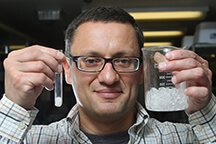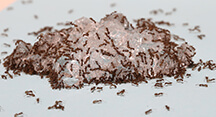Hydrogel baits offer novel way to manage invasive ants
February 18, 2015
 |
|
Entomologist Grzegorz Buczkowski holds a beaker of dry hydrogel crystals (left) and the same volume of crystals after they have absorbed water (right). (Purdue Agricultural Communication photo/Tom Campbell) |
WEST LAFAYETTE, Ind. - Water-storing crystals known as hydrogels can effectively deliver pesticide bait to invasive Argentine ants, quickly decimating a colony, a Purdue University study finds.
Pesticide sprays and baits are common tactics for managing pest ants. But sprays can have little long-term impact and carry environmental costs such as chemical contamination of soil and water sources. Baits also present challenges: Ants prefer liquid food to solids, rendering granular baits less appetizing. But liquid baits can be difficult and costly to dispense, maintain and clean up.
Associate professor of entomology Grzegorz Buczkowski (GRZHE'-gorzh buch-KOV'-skee) and fellow researchers tested the ability of hydrogels - crystals that can absorb 300 times their dry weight in water - to deliver liquid bait to invasive ants. They found that hydrogels saturated with a small amount of the chemical thiamethoxam dissolved in sugar water reduced the Argentine ant population in an orchard by about 94 percent in two weeks.
"When you drop hydrogels on the ground next to a colony, the ants really go crazy. It's like a big party," Buczkowski said. "This has great potential for managing invasive ants in other agricultural systems and natural environments. You could treat a whole vineyard using hydrogels."
 |
|
Argentine worker ants feed on hydrogels saturated with sugar water. (Purdue Agricultural Communication photo/Tom Campbell) |
The Argentine ant is the most widespread species of invasive ant, thriving in urban areas, agricultural settings and nature parks on every continent except Antarctica. The species can form "supercolonies" that link hundreds of nests and millions of workers. While Argentine ants do not bite or sting humans, they can be a nuisance in buildings and cause economic and ecological damage to agricultural businesses and natural areas where they outcompete native ant species.
In orchards and vineyards, the Argentine ant is a stalwart defender of aphids, which excrete a sweet honeydew that the ants drink. The ants protect the aphids from parasites, predators and parasitoids, allowing them to flourish and cause other problems such as sooty black mold, a dark fungus that can block leaves' access to sunlight.
Buczkowski and his team treated a plum orchard colonized by Argentine ants with small piles of hydrogel crystals saturated with 0.007 percent thiamethoxam dissolved in sugar water. Worker ants ate the bait and passed it on to the queens and larvae, decimating the population.
In laboratory tests, the bait crystals killed ant colonies in 3-5 days.
Hydrogel baits are inexpensive, easy to apply, need no dispenser and require a much smaller amount of insecticide than standard baits and sprays, reducing damage to the environment, Buczkowski said.
"We can drop the amount of the active ingredient to 0.0001 percent, and it's still effective," he said. "That is about a hundredfold less thiamethoxam than standard liquid baits and about a million-fold less than sprayers dispense."
Hydrogels also offer the advantage of selectively targeting ants, unlike sprays, which can kill beneficial insects such as bees and butterflies as well as pests.
While any ant species could eat the bait, non-target ant species have often been eliminated from areas invaded by Argentine ants or are not able to compete with Argentine ants for food sources - including the bait crystals, Buczkowski said.
Further research is needed to ensure that the hydrogel baits are not attractive to non-target insects, mammals or birds, he said.
The use of thiamethoxam in combination with hydrogels is not yet registered and was used only for experimental purposes in the study.
Using hydrogels to deliver insecticides was first tested by The Nature Conservancy, which teamed up with the National Park Service to rid Santa Cruz Island of Argentine ants. The ants had displaced native ant species on the island and were killing pollinating bees.
The paper was published in Entomologia Experimentalis et Applicata and is available to subscribers or through university access at http://onlinelibrary.wiley.com/doi/10.1111/eea.12239/full
Funding for the study was provided by Syngenta Crop Protection, the South African National Research Foundation and the Purdue University Industrial Affiliates Program.
Writer: Natalie van Hoose, 765-496-2050, nvanhoos@purdue.edu
Source: Grzegorz Buczkowski, 765-494-6314, gbuczkow@purdue.edu
Related website:
Purdue University Department of Entomology: https://ag.purdue.edu/entm/Pages/default.aspx
ABSTRACT
Hydrogel baits with low-dose thiamethoxam for sustainable Argentine ant management in commercial orchards
Grzegorz Buczkowski 1; Elray Roper 2; Darrin Chin 3; Natasha Mothapo 4; Theresa Wossler 4
1 Department of Entomology, Purdue University, West Lafayette, IN 47907, USA
2 Syngenta Crop Protection, Greensboro, NC 27409, USA
3 School of Chemistry, University of St. Andrews, St. Andrews, Fife, KY 169AJ, UK
4 Department of Botany and Zoology, University of Stellenbosch, Stellenbosch 7600, South Africa
E-mail: gbuczkow@purdue.edu
Argentine ants, Linepithema humile (Mayr) (Hymenoptera: Formicidae), are a significant pest in various agricultural systems around the world, and are often associated with outbreaks of phloem-feeding hemipteran insects. Previous research has evaluated a number of active ingredients and management approaches for controlling Argentine ant populations in agricultural systems, but various regulatory and economic issues have limited the development of effective management tools. Current chemical controls rely on residual sprays or toxic baits, each one posing unique disadvantages that limit their usefulness and efficacy. This study evaluated the potential of water-storing crystals to effectively deliver liquid baits to Argentine ants. The efficacy of bait crystals containing 0.007% thiamethoxam was first evaluated in laboratory colonies. In addition, field studies were performed in a commercial plum orchard to determine the efficacy of the bait crystals. Protein marking was used within the orchard to examine the distribution of the bait in Argentine ant populations when delivered via water-storing crystals. Results of laboratory tests showed that water-storing crystals containing 0.007% thiamethoxam are highly attractive and effective against Argentine ants and require ca. 3-5 days to kill all castes and life stages. Results of the protein-marking study demonstrated that the percentage of ants carrying protein-labeled sugar water decreases sharply with increasing distance from the bait station. Bait movement was limited to within 17 m of the bait dispenser. Furthermore, bait efficacy tests in the field showed that Argentine ants can be effectively controlled using liquid thiamethoxam baits deployed via water-storing crystals. The bait was highly effective and ant densities throughout the baited plots declined by 94 ± 2% within 14 days. The results of this study demonstrate that (1) thiamethoxam is highly effective for Argentine ant control in fruit orchards when used in low concentrations (0.007%), and (2) water-storing crystals are an effective tool for delivering liquid baits to Argentine ants in agricultural settings.
Ag Communications: (765) 494-2722;
Keith Robinson, robins89@purdue.edu
Agriculture News Page

